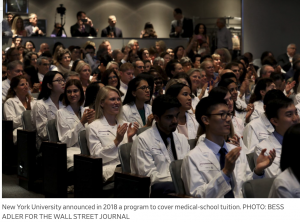When I started medical school in 1975, the tuition was $8500. This figure is indelibly imprinted on my brain since I was paying for it myself. I was able to make the payments through accumulated savings from two years of work before beginning school, low-interest loans, and a part-time job in the school emergency room. I finished school with about $25,000 of debt but I was able to pay off these loans in about ten years after graduating.
Inflation has averaged 1.41%/year since 1975 making $1000 in 1975 worth $5591 in 2024. By this metric, medical school today should cost about $47,523. But, alas, many schools are charging $100,000 or more. It’s not unusual for students to complete their studies and have $300,000 or more in debt to pay off.
Some medical schools are trying to address this problem. Thanks to a $1 billion donation, the Albert Einstein College of Medicine in New York recently announced that it would go tuition-free, joining a growing movement to sharply reduce the financial barriers that can deter aspiring doctors.
According to the AMA, it is estimated that more than 83 million people in the U.S. currently live in areas without sufficient access to a primary care physician. The American Association of Medical Colleges projects a national physician shortfall of at least 37,00 – and possible well over 100,000 – over the next decade.
Reasons for the Physician Shortage
The AMA lists the following reasons for the physician shortage:
- An increasingly impersonal and bureaucratic health care system that places enormous administrative hassles and burdens in our lap each day, and leaves us feeling powerless to make any meaningful change.
- Physicians today, on average, spend about two hourson paperwork for every one hour we spend with patients.
- An attack on science that undermines trust in our medical institutions, and too often leads to threats and hostility directed at us and other health care workers.
- Government intrusion into health care decisions and aggressive efforts in many states to criminalize care supported by science and evidence.
- Increasing consolidation across health care that is giving more power to our nation’s largest hospitals, health systems and insurers, and less autonomy and fewer choices to patients and doctors.
- Widening health disparities for historically marginalized communities, by race and by gender, between wealthy and low-income, and people living in urban and rural settings.
- The twin health crises of firearm violence and drug overdose.
- And for the last 20 years, a shrinking Medicare reimbursement rate for physicians that has pushed many small, independent practices to the brink of financial collapse and jeopardized care for millions of America’s seniors.
For all these reasons, the physician shortage is expected to get worse, not better. Therefore, solutions to this dilemma need to be found. Lowering the cost of medical school – even making it free – is an excellent idea. Thanks to the generosity of some donors, this may be possible.
Melissa Korn, writing for The Wall Street Journal, says some medical schools, like New York University, are taking the free-tuition-for-all-approach. Others, such as the medical school of Columbia University, award scholarships specifically for students who demonstrate financial need. Most schools also provide low-interest loans with flexible pay-back plans.
The programs, backed by hundreds of millions of dollars in donations, have led to jumps in applications at several of the schools. School officials say they show promise in attracting more students from underrepresented backgrounds, but critics warn their reach is limited given how selective most of the participating institutions are and how heavily some weigh standardized tests in admissions. But lowering standards for training doctors is not an option.
I am not an advocate of free college tuition, but to serve the growing need for physicians, such programs in medical schools make good sense, especially when they are paid for by generous donors and not the government. I would even support government subsidies if they are tied to commitments to practice in under-served remote areas of the country.
We certainly need to find ways to incentivize young people of all socioeconomic backgrounds to consider medical careers if we’re going to meet the growing need for physicians in our country now and in the future.


